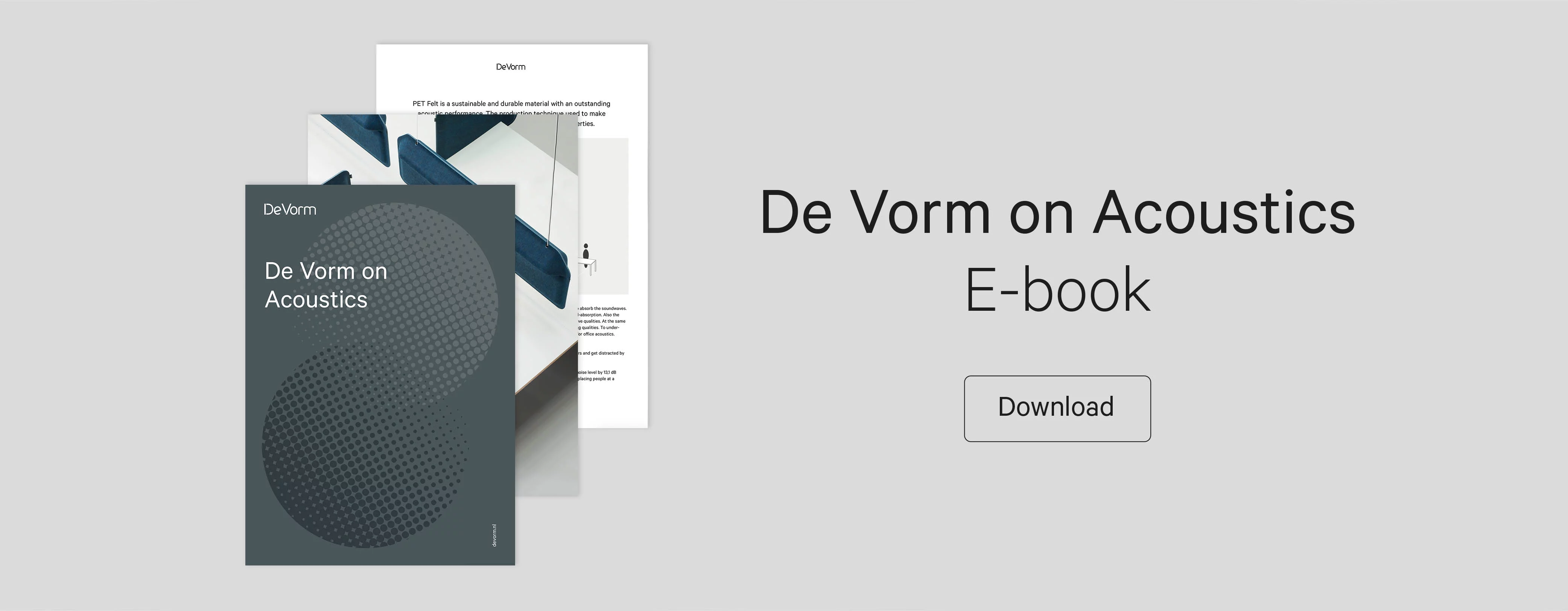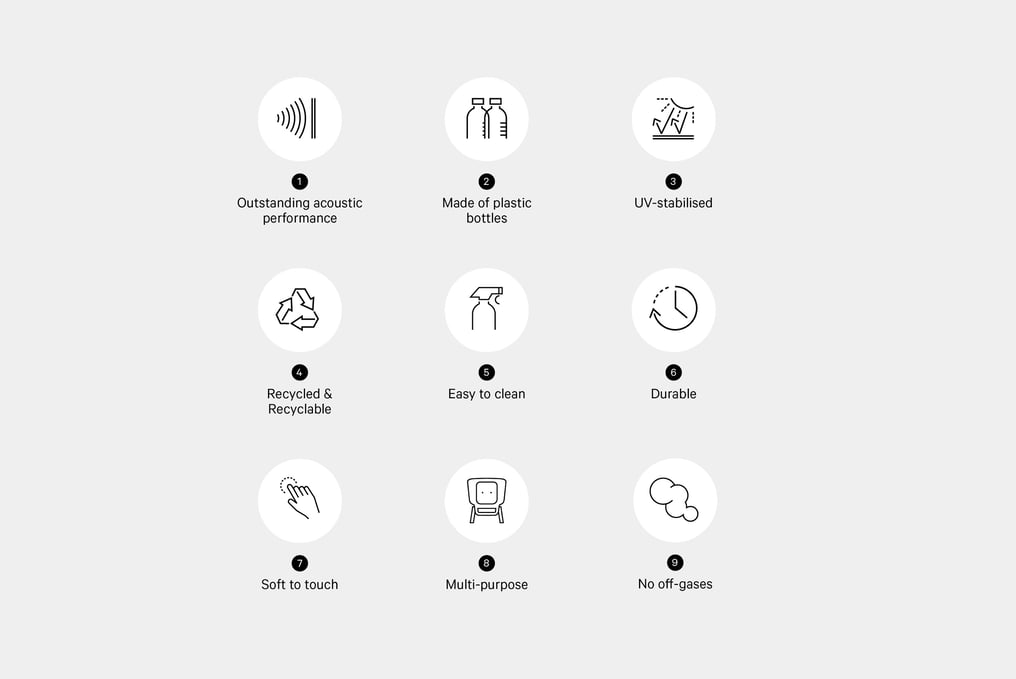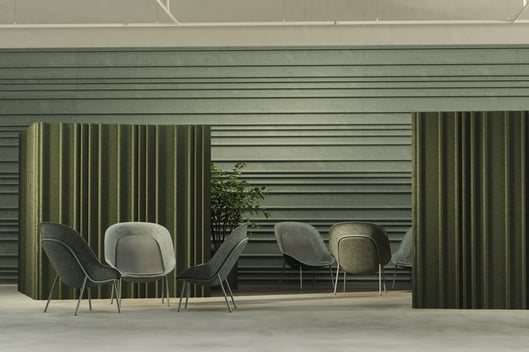Journal
De Vorm on Acoustics
People are affected by sounds at all times. They can be loud or quiet, pleasant or distracting, but they are always around. We cannot decide to hear or not to hear. But we can manage the environment to make the sounds work for and not against us. This is where acoustics comes in handy.

Here’s everything you need to know about the magic science of acoustics — what it does, why it matters and how to improve it. You can also  this page as a whitepaper. If you are looking for specific information, just jump to the section of your interest:
this page as a whitepaper. If you are looking for specific information, just jump to the section of your interest:
Contents: De Vorm on Acoustics
What is acoustics
Understanding the sound
Key acoustic properties & metrics
Absorption VS Reflection
Echo VS Reverberation
Three effects of sound
Physiological
Cognitive
Behavioural
Acoustics in different spaces
Why office acoustics matters
Noise as a top complaint in hospitality
Solve for acoustics
ABC of acoustic design
Expert advice for solving acoustic problems
Four acoustic solutions for noise reduction
PET Felt — a universal acoustic solution
Four PET Felt solutions for improved acoustics
Acoustic wall panels
Workplace & room dividers
PET Felt furniture
What is acoustics?
Acoustics is the science of sound. Namely the production, control, transmission, reception, and effects of sound. It explains how materials absorb and transmit the sounds, as well as how the acoustic surrounding affects people. In architecture, it is commonly understood as improving sound in different environments.
In order to understand how acoustics works, let’s take a closer look at what it deals with — the sound itself.
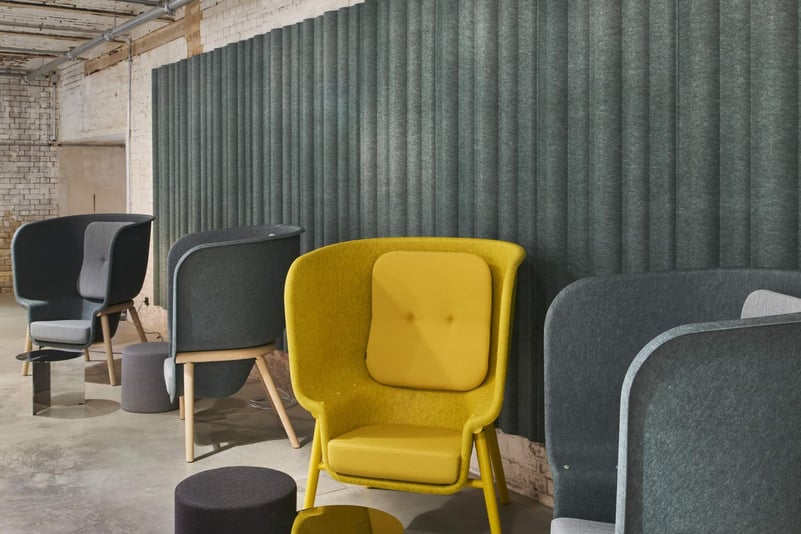
Understanding the sound
A scientific definition states that sound is
“a vibration that typically propagates as an audible wave of pressure, through a transmission medium such as a gas, liquid or solid.”
...putting it simply, sound can be described as
“a disturbance which travels through some medium.”
The visual depiction of such disturbance usually takes the shape of a wave. But does it really look like a wave? See for yourself.
As it turns out, sound waves do not look similar to ocean waves. Mainly because they are different in their nature. Ocean waves travel in up-and-down vibrations, while a sound wave vibrates in and against the direction of its movement. Such pattern squeezes the air in some areas and spreads it out in others. These alternating zones of compressed and spread-out air are known as compressions and rarefactions. In other words, sound pushes and pulls the air back and forth where water shakes it up and down.
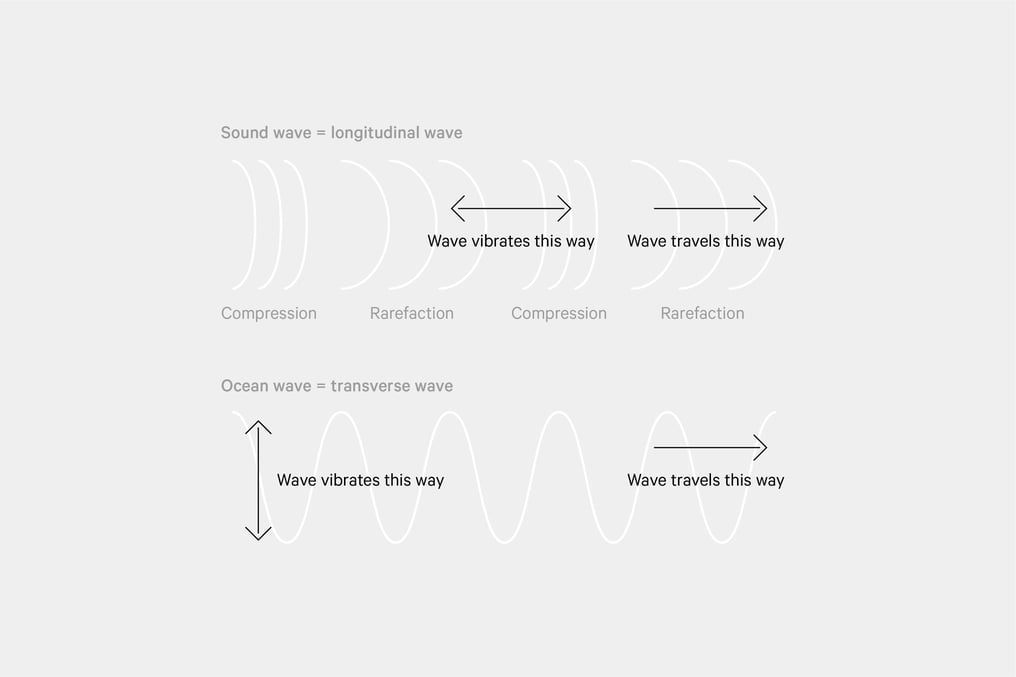 Now that we understand the nature of sound waves, let’s see how they interact with different media present in an environment.
Now that we understand the nature of sound waves, let’s see how they interact with different media present in an environment.
Key acoustic properties & metrics
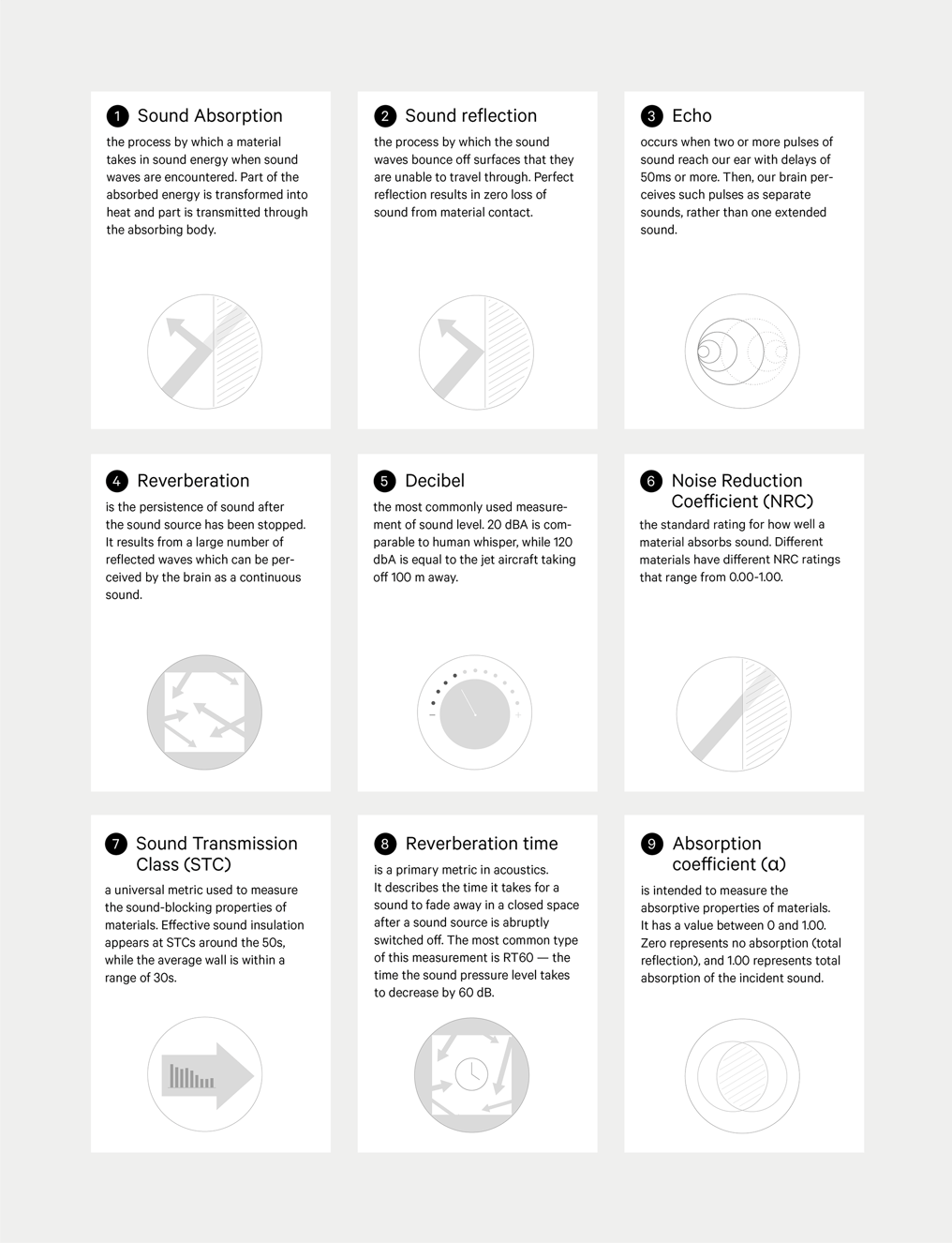
Absorption vs reflection
Solids, liquids and gases show various reactions when encountering sound waves. Three key processes happening when a material meets a sound wave are absorption, reflection, and transmission.
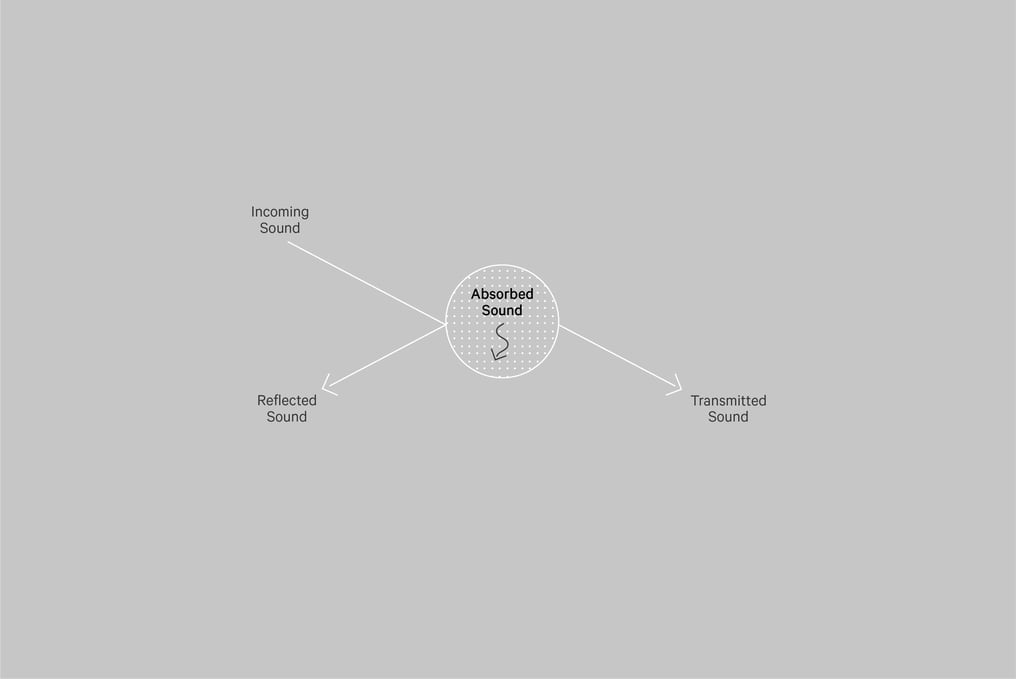 Sound absorption refers to the process by which a material takes in sound energy when sound waves are encountered. Part of the absorbed energy is transformed into heat and part is transmitted through the absorbing body. Respectively, sound reflection occurs when the sound waves bounce off surfaces that they are unable to travel through.
Sound absorption refers to the process by which a material takes in sound energy when sound waves are encountered. Part of the absorbed energy is transformed into heat and part is transmitted through the absorbing body. Respectively, sound reflection occurs when the sound waves bounce off surfaces that they are unable to travel through.
While all three processes can happen simultaneously, particular materials are known as sound-absorbing, while others are better for sound reflection. In general, soft, pliable, or porous materials (like cloths) serve as good acoustic insulators — absorbing most sound, whereas dense and hard elements (such as metals) reflect most of the sound waves.
Echo vs reverberation
These two terms are often confused and used interchangeably. In acoustics, they describe two different processes.
Take a look at the graph below:
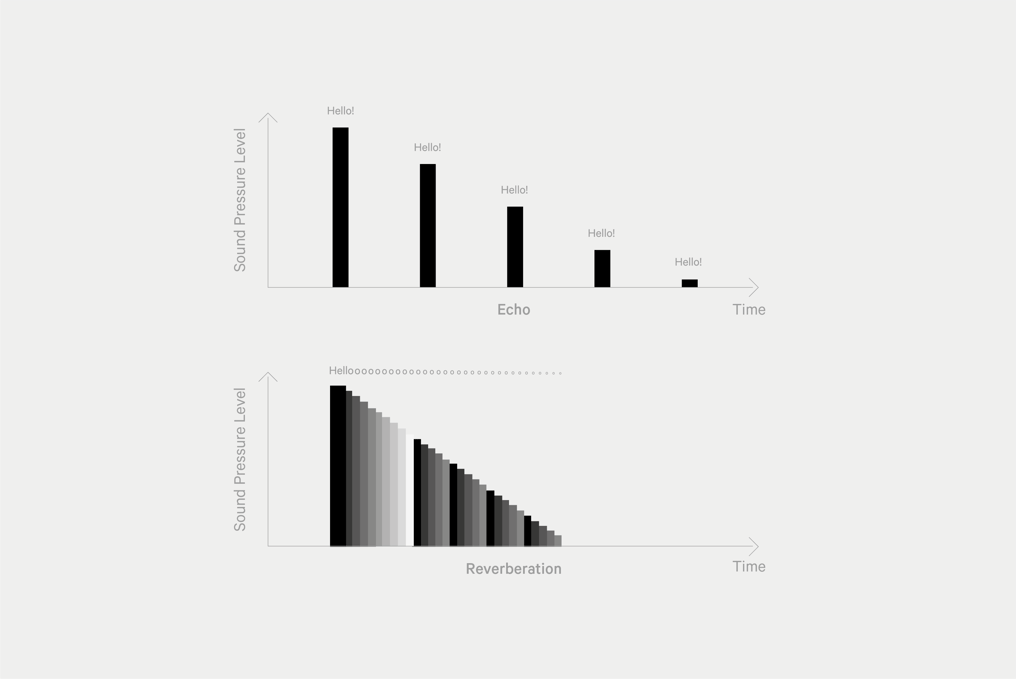 Source: 'What’s the difference between echo and reverberation?' by Clarke Roberts
Source: 'What’s the difference between echo and reverberation?' by Clarke Roberts
Echo occurs when two or more pulses of sound reach our ear with delays of 50ms or more. Then, our brain perceives such pulses as separate sounds, rather than one extended sound.
Reverberation is the persistence of sound after the sound source has been stopped. It results from a large number of reflected waves which can be perceived by the brain as a continuous sound.
While both processes result from sound reflection, they are differently perceived by people.
Reverberation time is a primary metric in acoustics. It describes the time it takes for a sound to fade away in a closed space after a sound source is abruptly switched off. The most common type of this measurement is RT60 - the time the sound pressure level takes to decrease by 60 dB.
The overall acoustic effect of certain materials primarily depends on their reflection and absorption properties. Surface textures, density and hardness, mass, thickness, support conditions, and the presence or absence of damping mechanisms also play a role here. It is the sum of all the mentioned factors that decides on the final acoustic performance of a certain object. But sound doesn’t only interact with materials. It affects human body as well. Let’s go through the general types of influence sound makes on people.
Three effects of sound
Why is sound so influential? Because it affects people on many different levels, including physiological, cognitive and behavioural.
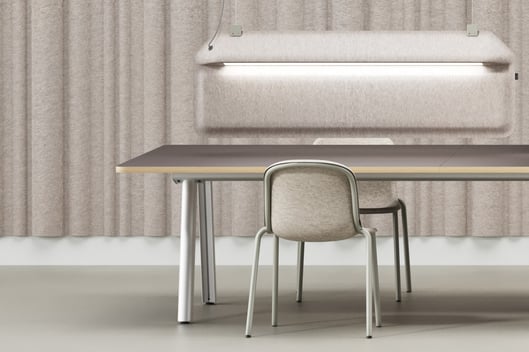
Physiological
Think about the last time you heard a sudden loud scream. What was your reaction? You probably got scared or caught by surprise. This reaction was caused by the release of cortisol in your body. Yes, noises can and do trigger the secretion of hormones. And it’s not the only effect they have. Sounds can change our heart rate, breathing and even our brain impulses. These reactions influence our organs in different ways. In the long run, the constant negative sound impact may lead to many kinds of health complaints, from gastric issues to sexual dysfunctions. So, ears are not the only part of our body suffering from excessive noise.
Cognitive
Concentrating in a noisy place can be very challenging. This is due to the cognitive limitations of our brain. We all have limited mental bandwidth for audio input. That’s why it is so hard to understand two people talking at once.
Likewise, when you are trying to focus on writing or reading and someone starts talking on the background, this takes away some of the processing capacity of your brain. But what do reading and writing have to do with audio perception? These two activities involve internal vocalization, the voice inside your head. And the brain finds it difficult to process both inner and external voices at the same time.
Behavioural
Fast music speeds up our actions. That’s why you hear it in fast-food stores, played deliberately to keep the customers moving along. Whereas, fashion shops often play slow-paced music to encourage shoppers to linger and buy more. Our walking and driving styles also change depending on the music we listen to.
Whilst fast music increases the speed at which we complete our tasks, it causes some people to make more mistakes. The impact of music on performance differs. Some people demonstrate better concentration and attention, while others consider music to be as distracting as noise.
Taking into account numerous effects the sound has on us, it becomes clear that the importance of acoustics cannot be overestimated. It influences our mood, performance and overall well-being. In public spaces, sound management should be of paramount importance. Too much noise in the office will have a drastic effect on so many people. Same works for restaurants and bars. What are the main acoustic problems in those places?
Acoustics in different spaces
Numerous academic studies have confirmed that office acoustics has a huge impact on employees. Noisy workplaces can negatively affect anything from workers’ health to their motivation. The scope of such influence generally depends on people’s sensitivity to distractors, the type and volume of sounds as well as the acoustic properties of the environment. However, this doesn’t change the scientific consensus — a noisy office hampers the team’s well-being and performance.
To get a clear picture, let’s take a look at the numbers:
- • When people hear someone speaking next to them while reading or writing, their productivity can drop as much as 66%
• Noise accounts for 71% of all workplace distractions
• Other people’s voices are the most cited source of distraction in the office
• 70% of employees say their efficiency would increase if their workplace wasn’t as noisy
• Job stress prevalence among workers in high noise conditions is 55%
The facts speak for themselves. In order to ensure well-being and productivity at work, acoustics should be a primary consideration in the office design. However, it is often overlooked, leading to increasing numbers of unsatisfied employees.
Bas Möllenkramer, an expert in office acoustics, says that proper sound management is at the cornerstone of creating a healthy workplace:
"According to the basic needs of the Maslow Pyramid, everyone needs safety and security. I believe that a healthy workplace is a substantial part. This is where the acoustics have to meet the necessary conditions, i.e. a room with little echo and reverberation''.
 You can check the noise level in the office to see whether it is suitable for comfortable working. There are plenty of free mobile noise meters available.
You can check the noise level in the office to see whether it is suitable for comfortable working. There are plenty of free mobile noise meters available.
Noise as a top complaint in hospitality
According to the 2018 Zagat Survey, noise is the biggest complaint amongst restaurant-goers, even before poor service or substandard food. People who are offended by noise levels tend to leave early and are less likely to return. Noise is clearly not good for business. To make matters even worse, excessive noise is also shown to have a negative effect on taste.
Charles Spencer from the University of Oxford found that “both background noise and loud music can impair our ability to taste food and drink. It would appear that noise selectively impairs the ability to detect tastes, such as sweet and sour while leaving certain other taste and flavour experiences relatively unaffected.”
Besides the influence that noise has on taste, consider the effect it has on socializing. Talking to and hearing your companions. To have a conversation without shouting to make yourself heard. As this article puts it, “You go to restaurants to be social. These days, you often come out none the wiser of what the other person has said.”
Not only is loud noise a problem for patrons. It can also be a serious health hazard for the staff. Noise levels in restaurants regularly reach a mark of 90 decibels. Anything over 80 dB is considered harmful to hearing on a regular basis. Considering that the decibel scale is exponential, it means that when the noise goes from 80 to 90 dB, it is 10 times more intense and twice as loud. So, acoustic problems require extra attention. How to solve them?
Solve for acoustics
Now that we know the nature of sound and and different aspects of its influence, let’s turn to managing the noise. There are three general mechanisms to use — sound absorption, sound blocking and sound covering.
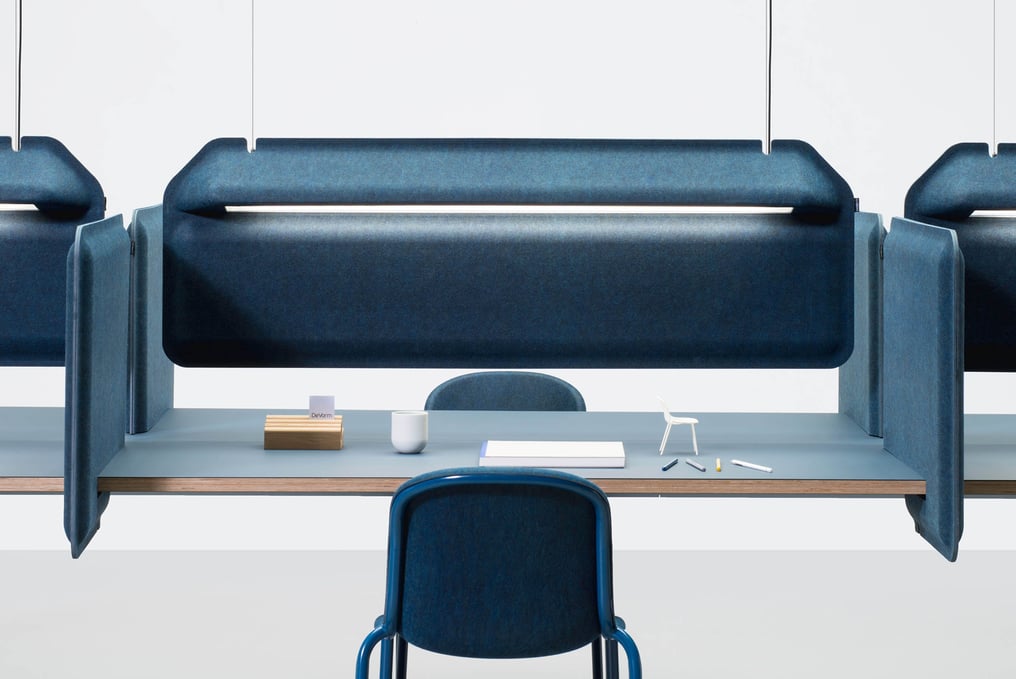
ABC of acoustic design
Absorbing
Certain materials can take in sound energy and partly transform it into heat. This quality is known as sound absorption. As a result, the intensity of the sound is minimized to a certain degree. Sound absorption helps to deal with the noise directly by removing it from the space. Such solutions are considered to be the most effective in acoustic design. These include soft wall and flooring materials, like acoustic panels and carpets, along with room dividers and some types of furniture. You can check the NRC (Noise Reduction Coefficient) rating of such products to see how well they absorb the sound.
Blocking
Sound blocking or soundproofing occurs when the sound waves bounce off surfaces that they are unable to travel through. In other words, such materials prevent the sound from entering or leaving a particular space. As opposed to absorbing elements, soundproof solutions are made from dense solid materials, like cement or metal. Such products receive an STC (Sound Transmission Class) to measure their sound-blocking properties.
Covering
Sound covering is the process of adding background sounds to reduce noise distractions. Yes, you got it right — covering means reducing noise by adding extra noise. Contradictory as it is, the technique is proven to work. By raising the ambient noise level, you can make human speech less intelligible and therefore less distracting. Sound masking can be achieved by engineering an ambient sound similar to airflow that matches the frequencies of human speech. As a result, human conversations can be heard on a much smaller radius.
Expert advice for solving acoustic problems
Many acoustic problems present in different environments can be easily solved. Consider these tips to make your workplace pleasing to the ears of employees:
- • Floor, ceiling and wall covering. These are the main surfaces in any space, therefore, choosing sound-dampening covering for walls, ceiling and floor would do most of the work in improving overall acoustics.
• Masking conversations. Human speech is a number-one distraction in the office. Loud conversations are also a primary complaint in hospitality. When designing public spaces, consider installing sound-covering solutions to mask human voice.
• Noise localization. Separate the main sources of noise from the rest of a space. For instance, all loud office equipment or cooking appliances can be put in a separate space. Noisy rooms, like kitchen in a restaurant or canteen in the office, need extra sound isolation.
• Acoustic expert. Involving an expert to the design process would be of great value. However, it is not always possible and affordable for all projects.
 PET Felt Panels used as a warm and acoustic ceiling covering in the 330 Park Collective Studio, interior design by Archier.
PET Felt Panels used as a warm and acoustic ceiling covering in the 330 Park Collective Studio, interior design by Archier.
For those planning to solve acoustic problems on their own, we’ve asked our acoustic consultant Bas Möllenkramer to share his golden rules for reducing noise:
- • The European directives from NPR 3438 form a good foundation of acoustic management in the workplace. Pay special attention to articles 34-38. In short: ensure sufficient absorption to shorten the reverberation time.
• Prevent reflection from the ceiling. Industrial-style open ceilings are gaining popularity nowadays, but at the same time they become the main cause of reverberation.
• Measuring is key. The acoustic properties of any room can be better understood by measuring them. With this knowledge, you should calculate to determine the right solution.
• Trial and error. Just start somewhere and you will learn from experience. Sometimes you will discover that some things don’t work. Then you have to try and test them again to find the right acoustic solution.
Taking into account the above-mentioned advice, let’s take a look at some simple ways of noise reduction.
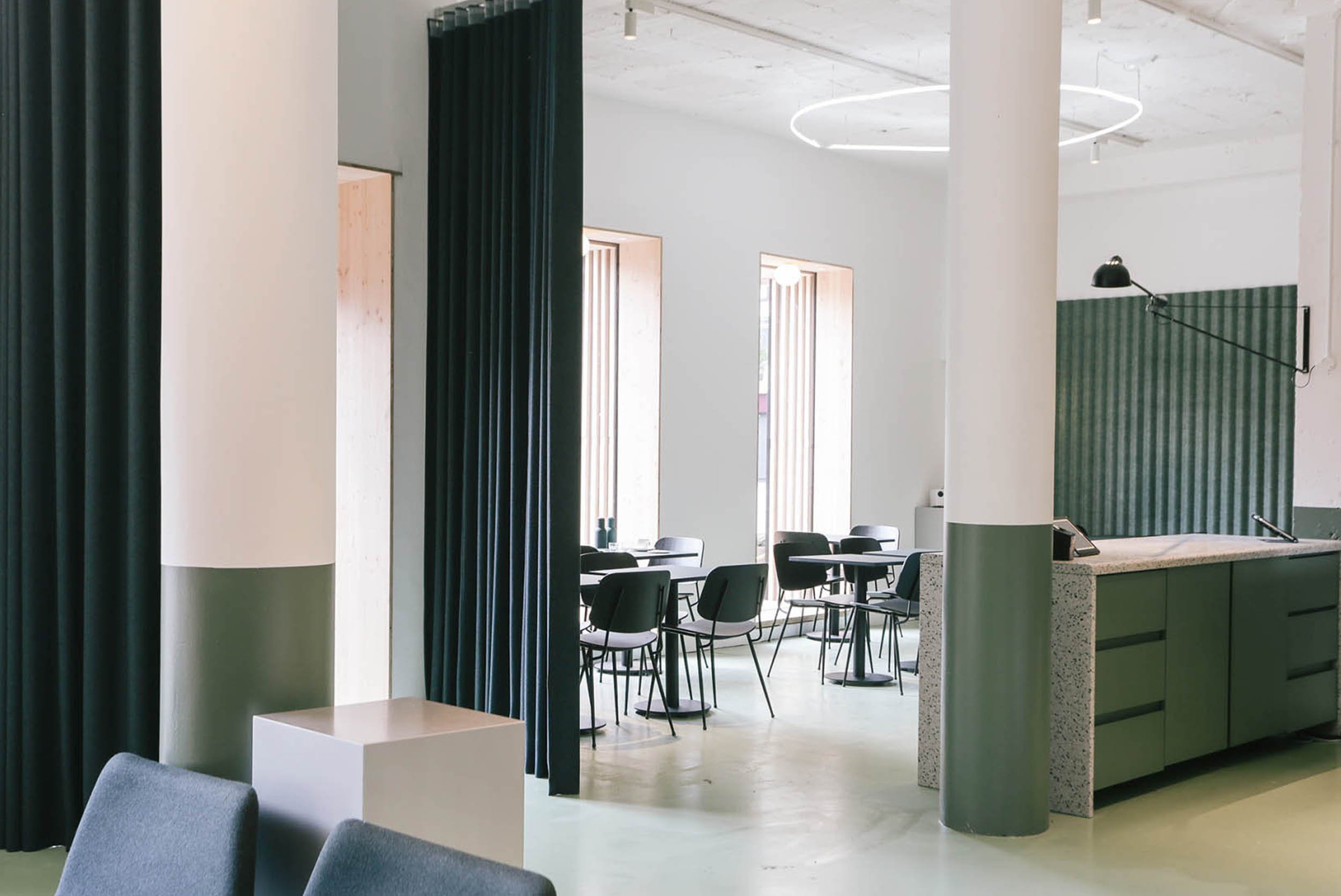 Olive coloured Mute PET Felt Acoustic Panels in the coffee shop Sans Pere, interior design by Atelier Baulier.
Olive coloured Mute PET Felt Acoustic Panels in the coffee shop Sans Pere, interior design by Atelier Baulier.
Four acoustic solutions for noise reduction
Still hungry for ideas? Here is some inspiration for you! Consider these acoustic solutions to easily dampen the noises in any space:
Acoustic wall panels
Wall panels are an effective way of combating noise in every space. Nowadays, there are plenty of options to choose from — such panels can be made from compressed foam, wool, wood or even recycled plastic bottles. PET Felt is a great choice for your acoustic walls in the office. Not only do these panels provide sound-absorbing properties, but they are also easy to process and customize. As a result, PET Felt panels can be easily produced into endless variations of shape and form to contribute to the aesthetic look of your design.
Privacy furniture
Some furniture is specifically designed to create a sensation of privacy. Shielded chairs and high-back sofas can be used to create a room within a room separating its users from the environment. Acoustic properties play a crucial role here, so it’s advisable to choose furniture made from sound-absorbing or sound-blocking materials.
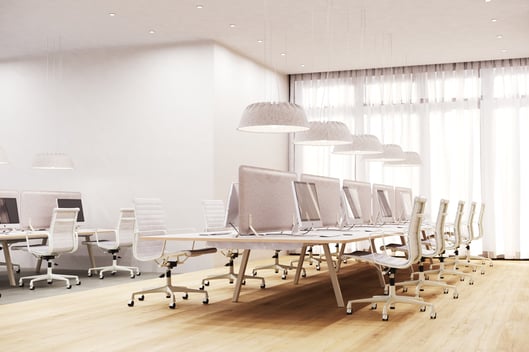
Room dividers
Another simple way to improve acoustics is installing room dividers. Specifically designed to minimize the noise, these objects also help you zonate the space in a simple way. Space dividers absorb the sounds where it’s needed the most. An additional benefit of having such movable walls is that the space layout can be easily adjusted to the particular purposes of the space — a large conference table can become a working station, while a hall in a restaurant can be broken into smaller private zones.
Plants
Apart from the obvious benefits in terms of aesthetics and air quality, plants are also proven to be effective noise reducers. They deflect and absorb sound waves, improving the overall acoustic quality of the space. Plants can be used to create green walls or separate the work stations. Some plants absorb sound better than the others. Peace Lily, Ficus, Ferns and Weeping Fig are on the top of the list.
![]()
PET Felt — a universal acoustic solution
PET Felt is a sustainable and durable material with an outstanding acoustic performance. The production technique used to make PET Felt provides its unique noise reduction properties.
It is the highly porous structure of the PET Felt which allows it to absorb the soundwaves. Applying multiple layers on top of each other increases its sound-absorption. Also the lower the level of pressing the higher the level of sound-absorptive qualities. At the same time, densely pressed PET Felt also demonstrates sound-blocking qualities. To understand how it works, let’s consider a case of PET Felt application for office acoustics.
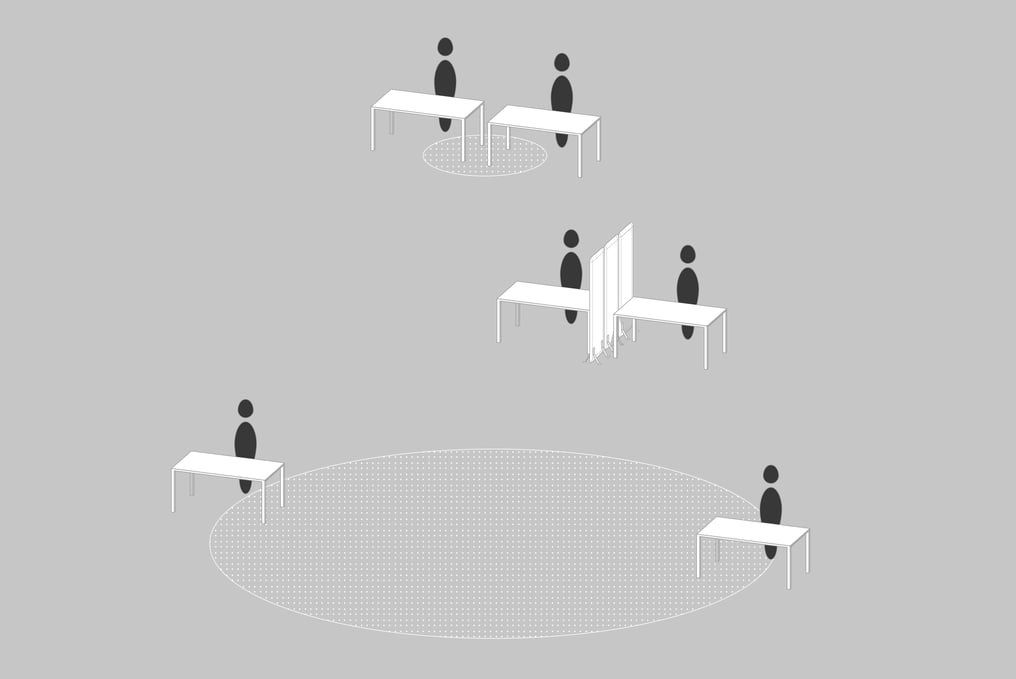
Case in point
Two people are sitting next to each other at a distance of 2 meters and get distracted by each other’s phone conversations. Placing three AK 4 room dividers between them will reduce the noise level by 13,1 dB (all other conditions remaining the same). This effect is equal to placing people at a 9-meter distance from each other.
9 facts about PET Felt
Four PET Felt solutions for improved acoustics
Acoustic wall panels
Thanks to its sound-absorption properties, PET Felt is extensively used to make acoustic panels and wall decor. This material is quite flexible in terms of processing and application allowing designers to create endless variations of shapes and patterns. Optionally, they can be applied to the ceiling or hung horizontally for an improved acoustic effect.
Bonus tip
In the case of a cut-out design, consider applying a plain PET Felt panel under a patterned one for better sound absorption. Placing two layers of wall panels with a gap in between will also increase their acoustic performance.

Case in point
Applying Mute PET Felt panels directly on the surface guarantees a Noise Reduction Coefficient (NRC) of 0.60. This means that the panels absorb 60% of sound energy coming in contact with them.
Alternatively, the Mute panels can be placed 50 mm from the surface. The NRC in this case equals 0.75. This has a particularly positive effect on absorbing the lower frequencies of sound.
Filling the cavity with stone wool will improve the acoustic performance of a panel even more, increasing the NRC to 0.9 (with the maximum possible value of 1.0).
*data collected during the experiment in a reverberation room
Workplace & room dividers
Acoustics can be greatly improved by PET Felt workplace and room dividers. The main benefit of these movable walls is that they absorb noises locally — right where it’s needed most — at the shared desks, in quiet zones or around individual workstations. Thus, the users can adjust the space and its acoustics according to their needs.
PET Felt furniture
PET Felt is also used to make office furniture. The 3D pressing technique shapes the sheets of felt into a sturdy form. This way, you can get an acoustic alternative to the traditional pieces of the interior, like chairs and lamps. PET Felt is an excellent choice for privacy furniture making it not only visually shielding, but also sound blocking.
PET Felt collection by De Vorm is available in 11 unique colour blends. Different products can be matched with each other to create the office design that’s equally pleasing to the eyes and ears.
